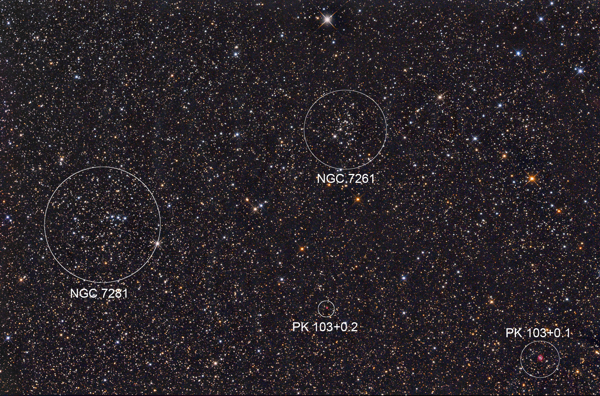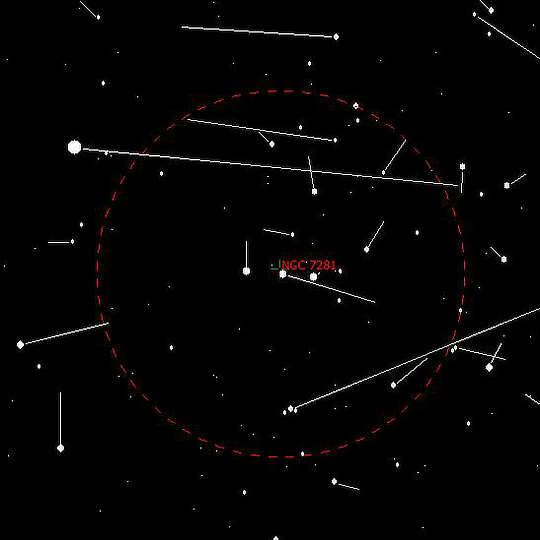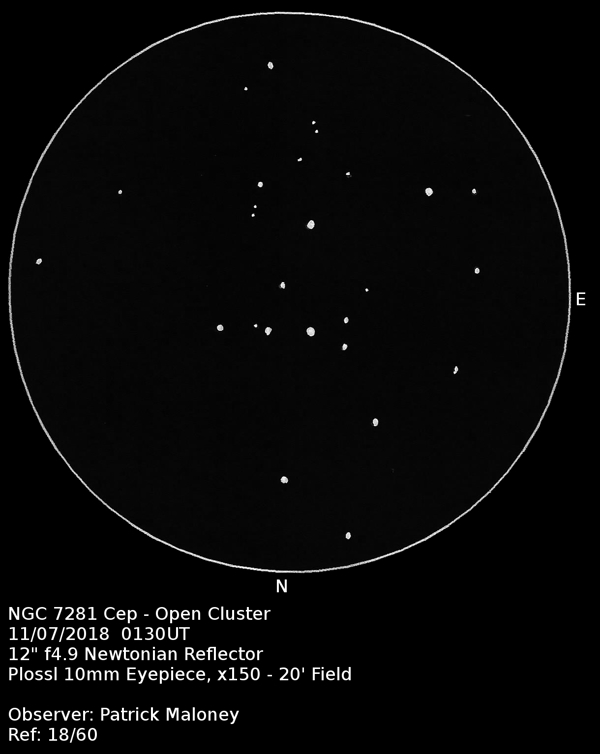NGC 7281 and NGC 7261 in Cepheus
September 2022 - Nebula and Cluster of the Month
This month we’re going to look at two objects, which may together be considered as an ‘Unsung Double Cluster’. Of course, it’s not as bright or spectacular as the famous Double Cluster in Perseus (NGCs 869 and 884), but it’s nice to come across two objects that can fit in the same low-power field.
NGC 7261 and NGC 7281 lie in Cepheus and are virtually overhead during September nights. Both were discovered by John Herschel, during his sweep number 215 on 5 October 1829. They first appeared in his 1833 catalogue as JH 2159 and JH 2161.
NGC 7261 – the smaller of the two – he described as …a coarse, pretty rich cluster which fills the field. Stars 10–15 magnitude
whereas NGC 7281 was Large, coarse, not extremely poor, the stars scattered and 10 – 16 magnitude.
What exactly he meant by ‘not extremely poor’, is anyone’s guess, but it carries the whiff of damning with faint praise.
The clusters lie 41’ apart, and will fit into a good, low-power field. Both are quite easily discerned against the background stars, despite neither of them being particularly bright or rich. Wide-angle photographs of the area show them, but they don’t stand out as clearly photographically as they do visually.

As ever, the Trumpler classifications of these objects vary from listing to listing, NGC 7261 variously being listed (amongst others) as II3m or III2p meaning ‘detached with strong central condensation (or little central condensation), a wide range of brightnesses with bright and faint stars (or only a moderate range), 50–100 stars (or fewer than 50 stars)’. Deep-Sky Field Guide (DSFG) quotes a membership of 30 stars, whereas Archinal & Hynes give 62. WEBDA has proper motion data for only two stars.
NGC 7281 fares a little better, being classed as IV2p or IV1p (Not well detached, moderate range of brightnesses (or most of the stars are of the same brightness), poor. The number of stars is generally given as 20, but WEBDA lists proper motions for 33 stars which are probably involved.
The question must be asked: are these two clusters actually physically associated, or are they simply in the line of sight of each other? The distances quoted on WEBDA for the clusters’ distances are 1681pc (about 5500 light-years) for NGC 7261 and 1620pc (about 5400 light-years). The error bars for these distances overlap each other, so a physical connection would, on the face of it, seem a possibility.
However, data from the Gaia mission renders a distance of 2119pc (6900 light-years) for NGC 7261, which would put it way behind NGC 7281. I have not seen any Gaia data for NGC 7281. Maybe that’s been pushed further out as well.
A further spanner in the works is that NGC 7281 is possibly not a true cluster at all. DSFG has the phrase ‘Probably not a cluster’ in its notes and this is passed on by Archinal & Hynes. The WEDBA data for 33 stars with comparable proper motions does seem to mitigate against this and support the case for 7281 being a true cluster. My own rather limited investigation suggests that none of the brighter stars in the immediate area share any proper motion. Certainly, the three brightest stars – which form an immediately obvious straight line – are all travelling in different directions and at different speeds, (see below).

I have made a single observation of NGC 7261 and two of NGC 7281.
NGC 7261: With thin, high cloud covering the whole sky, this wasn’t an ideal night for observing. NGC 7261 appeared as small, well detached and somewhat concentrated. About 15 stars were seen through the thin cloud. It looks promising for a better night. The brightest stars form a quadrangle with the brightest star in the cluster (about mag 9.5) at its eastern point. (No drawing made).
NGC 7281(1): Small, not well detached and only moderately compressed. Maybe 20 stars seen over about 10'. The cluster is dominated by three 10th magnitude stars in a short straight line. (No drawing made).

NGC 7281(2): Shaped like a bent capital letter ‘T’. The three brightest stars, forming a straight line, are magnitude 10. The proper motions of these stars demonstrate that they are not physically connected. (Drawing 18/60).
| Object | RA | Dec | Type | Magnitude |
|---|---|---|---|---|
| NGC 7261 | 22h 20’ 10” | +58° 06’ 35” | Open Cluster | 8.4 |
| NGC 7281 | 22h 24’ 57” | +58° 50’ 27” | Open Cluster | Br* = 10.2 |